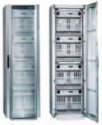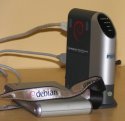Nokia selects Red Hat for carrier equipment
November 15, 2006 Nokia's Network Business Group has selected Red Hat Linux as the primary OS for its carrier-grade server platforms, Red Hat reports. Nokia will integrate Red Hat Enterprise Linux (RHEL) on multiple FlexiPlatform products this year, with Red Hat providing onsite consulting, support, certification, and training services. (more…)
Nokia's Network Business Group has selected Red Hat Linux as the primary OS for its carrier-grade server platforms, Red Hat reports. Nokia will integrate Red Hat Enterprise Linux (RHEL) on multiple FlexiPlatform products this year, with Red Hat providing onsite consulting, support, certification, and training services. (more…)
 The “Slug” has gained much-improved Linux support, thanks to a new Debian installer that targets the device. The first release candidate of the debian-installer for Debian's forthcoming “Etch” distribution was released yesterday, offering nearly complete support to the Linksys $99 NSLU2 NAS gadget.
The “Slug” has gained much-improved Linux support, thanks to a new Debian installer that targets the device. The first release candidate of the debian-installer for Debian's forthcoming “Etch” distribution was released yesterday, offering nearly complete support to the Linksys $99 NSLU2 NAS gadget.  Linux powers more than 75 percent of the world's most powerful computers, according to data released yesterday in the annual “Top 500” report. Intel's Pentium 4 Xeon proved the most popular processor, followed by dual-core Opteron and EM64T Xeons in a dead heat for second.
Linux powers more than 75 percent of the world's most powerful computers, according to data released yesterday in the annual “Top 500” report. Intel's Pentium 4 Xeon proved the most popular processor, followed by dual-core Opteron and EM64T Xeons in a dead heat for second.  One of the first POS (point-of-sale) equipment vendors to adopt Linux will now become one of the first to offer solid-state storage. Wincor Nixdorf's new X-Series, due in January, will be offered with an Msystems mModule uDOC embedded flash disk.
One of the first POS (point-of-sale) equipment vendors to adopt Linux will now become one of the first to offer solid-state storage. Wincor Nixdorf's new X-Series, due in January, will be offered with an Msystems mModule uDOC embedded flash disk.  AMD has stopped producing the Personal Internet Communicator (PIC), a low-cost computer intended to help equip 50 percent of the world's population with Internet and computing capabilities by 2015. The news was contained in an obscure paragraph of the company's quarterly SEC 10-Q filing.
AMD has stopped producing the Personal Internet Communicator (PIC), a low-cost computer intended to help equip 50 percent of the world's population with Internet and computing capabilities by 2015. The news was contained in an obscure paragraph of the company's quarterly SEC 10-Q filing.  This detailed, informative whitepaper discusses factors for success in using Linux as an embedded OS. Topics covered include hardware selection, distribution selection, Linux vs.
This detailed, informative whitepaper discusses factors for success in using Linux as an embedded OS. Topics covered include hardware selection, distribution selection, Linux vs.  An open source project maintaining an embeddable (within other applications) relational database has achieved a major release. Firebird 2.0, which debuted at the fourth International Firebird Conference this week in Prague, features new SQL, internationalization, security, and performance features.
An open source project maintaining an embeddable (within other applications) relational database has achieved a major release. Firebird 2.0, which debuted at the fourth International Firebird Conference this week in Prague, features new SQL, internationalization, security, and performance features.  Low-level, flash filesystem software provides critical functionality on contemporary wireless handheld devices, ensuring that data can be written to the storage media, accessed by the user, and read on demand.
Low-level, flash filesystem software provides critical functionality on contemporary wireless handheld devices, ensuring that data can be written to the storage media, accessed by the user, and read on demand.